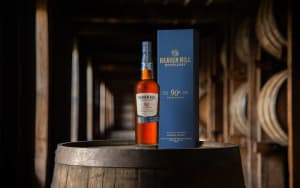Every bourbon drinker knows the old saying: age doesn't guarantee greatness. Barrels can turn on you after too many summers, leaving behind bitter tannins or flat, over-oaked spirits that taste more like furniture than fine whiskey. Yet every few years, a bottle arrives that silences the skeptics. Michter’s just did it again with their 2025 release of the 20 Year Kentucky Straight Bourbon, a whiskey that spent two full decades locked in brand-new charred oak and somehow emerged richer, deeper, and more balanced than most expressions half its age.
The bottles started hitting shelves in early December, right after Thanksgiving weekend when serious collectors begin their annual hunt. At a suggested retail of $1,200 for a 750ml bottle, this isn't a pour for casual Friday nights. But for the man who keeps a dedicated whiskey shelf in his den and still remembers the first time he tasted Pappy 23, the price feels less like extravagance and more like admission to a rare event.
Michter’s president Joseph J. Magliocco doesn't sugarcoat the challenge. “By law bourbon must be aged in a brand-new barrel, which imparts flavor, color and oak character more quickly than a used barrel,” he said in a statement. “To age a whiskey that will taste wonderful after two decades in a first-use barrel is an extremely difficult endeavor that requires a skillful balance of art and science. I believe that people will appreciate the thoughtful and conscientious work of our production team when they taste this exceptional whiskey.”
That production team reads like a bourbon dream roster. Master Distiller Dan McKee and Master of Maturation Andrea Wilson personally signed off on every barrel that made the cut. McKee, who grew up in Kentucky and cut his teeth at some of the state's most respected distilleries, brings the technical precision. Wilson, one of the industry's most respected voices on barrel management, controls the warehouse environment with the kind of attention usually reserved for vintage wine cellars.
The proof came in at 114.2—57.1% alcohol by volume—slightly lower than last year's 114.3 but still carrying enough punch to stand up in a Glencairn glass without water. Early reports from retailers who cracked their allocation samples describe a nose thick with dark cherry preserves, old leather, and the kind of baking-spice warmth that reminds you of your grandmother's kitchen during holiday cookie season.
Wilson's official tasting notes paint the full picture: “Michter’s 20 Year Bourbon is an exemplary representation of how oak can be used to deepen vanilla, toffee, chocolate, spice, fruit, and confectionery notes that enhance complexity in bourbon.” She added, “We hope that everyone who gets the opportunity to taste this product is able to experience the beloved attributes of a beautiful, timeless bourbon crafted through intentional aging.”
The phrase "intentional aging" carries real weight at Michter’s. While their Shively distillery in Louisville now produces the whiskey that fills their 10-year and younger bottles, these 20-year barrels contain contract-distilled spirit laid down long before the stills fired up in Kentucky. The company won't name the source—industry insiders point toward the usual suspects in Indiana and Tennessee—but the quality speaks louder than any mash bill disclosure.
This marks Michter’s return to annual 20-year releases after skipping 2023 entirely. The barrels earmarked for that year simply didn't meet the standard, a decision that cost real money but preserved the brand's reputation. Compare that to the growing pile of "dusty" old bourbons hitting the market—some 18-plus-year expressions that taste like liquid potpourri—and Michter’s restraint starts looking like wisdom.
They're not alone in proving extreme age can work. Redemption stunned collectors last spring with an 18-year rye that drank like liquid Christmas cake. Knob Creek's new 21-year bourbon somehow improved on their already excellent 18-year, adding layers of dried fig and tobacco without tipping into bitterness. But Michter’s 20 occupies its own tier, partly because of the brand's track record and partly because they release so little of it.
The whiskey's journey begins in warehouses where temperature swings are measured in fractions of degrees and humidity stays within tight parameters. Wilson monitors each rick, rotating barrels as needed and pulling samples that go through rigorous blind tasting panels. Only when McKee and Wilson both give their nod does a barrel earn its place in the final blend.
Michter’s operates three Kentucky properties that tell the full story of their ambition. The Shively plant handles primary distillation for younger whiskey. Down in Springfield, 205 acres of estate grain grow under the same soil and sun that will eventually feed future barrels. And in downtown Louisville, the Fort Nelson Distillery—housed in a restored 1890s building across from the Louisville Slugger Museum—runs the legendary pot stills brought down from the original Michter’s in Pennsylvania.
Fort Nelson does more than make whiskey; it serves as Michter’s public face. The Bar at Fort Nelson pours classic cocktails under the guidance of spirits historian David Wondrich, and the tour ends with tastes that make the $1,200 bottle upstairs seem almost reasonable by comparison.
Three months before the 20-year announcement, Drinks International named Michter’s The World's Most Admired Whiskey for the third time—an unprecedented streak decided by a panel of 100 global experts including bartenders, journalists, and distillers from Scotland to Japan. The timing feels deliberate: release the ultimate expression right after claiming the crown.
For collectors, the math works like this: $1,200 at retail becomes $2,500–$3,000 on the secondary market within weeks, assuming you can find a bottle at all. Most shipments go to allocated accounts—high-end steakhouse bars, specialty retailers with long waiting lists, and the occasional restaurant group that buys a case for their VIP program. The smart money camps out at their local store the week before December 1, cash in hand and a good story ready about why they deserve one of the three bottles in stock.
McKee sums up the team's philosophy simply: “Our production team takes great pride in offering such a special whiskey. A lot of time and effort goes into maturing these barrels so that they are extraordinary for this release.”
Twenty years is a lifetime in bourbon terms. Distillers who laid down these barrels in 2005 couldn't have predicted the current whiskey boom, the tariff wars that would reshape grain prices, or the pandemic that emptied bars for eighteen months. They certainly couldn't control Kentucky weather—scorching summers followed by polar vortex winters that stress even the sturdiest white oak staves.
Yet here stands a bottle that survived it all. The deep amber color comes honest, pulled from wood that gave up its essence slowly, year after year. The flavor layers—vanilla bean scraped fresh from the pod, toffee cooked to the perfect golden stage, dark chocolate with a whisper of orange peel—didn't happen by accident. They required constant attention, endless sampling, and the kind of patience most companies abandoned when allocated whiskey started selling itself.
Pour it neat in a heavy rocks glass, the kind with a solid base that feels substantial in your hand. Let it breathe for five minutes while you think about the work behind it. Then take a sip and understand why some barrels earn their twenty years while others get bottled at twelve and thanked for their service.
Michter’s 2025 20 Year Bourbon won't be the last great old whiskey—Redemption and Knob Creek proved the category still has legs—but it sets the standard for what careful stewardship can achieve. In a market flooded with hype and hyperbole, this bottle delivers the rarest commodity of all: proof that time, handled right, remains the ultimate ingredient.




